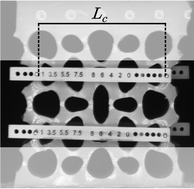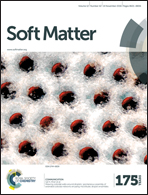Programmable mechanical metamaterials: the role of geometry†
Abstract
We experimentally and numerically study the role of geometry for the mechanics of biholar metamaterials, which are quasi-2D slabs of rubber patterned by circular holes of two alternating sizes. We recently showed how the response to uniaxial compression of these metamaterials can be programmed by lateral confinement. In particular, there is a range of confining strains εx for which the resistance to compression becomes non-trivial–non-monotonic or hysteretic—in a range of compressive strains εy. Here we show how the dimensionless geometrical parameters t and χ, which characterize the wall thickness and size ratio of the holes that pattern these metamaterials, can significantly tune these ranges over a wide range. We study the behavior for the limiting cases where the wall thickness t and the size ratio χ become large, and discuss the new physics that arises there. Away from these extreme limits, the variation of the strain ranges of interest is smooth with porosity, but the variation with size ratio evidences a cross-over at low χ from biholar to monoholar (equal sized holes) behavior, related to the elastic instabilities in purely monoholar metamaterials. Our study provides precise guidelines for the rational design of programmable biholar metamaterials, tailored to specific applications, and indicates that the widest range of programmability arises for moderate values of both t and χ.


 Please wait while we load your content...
Please wait while we load your content...